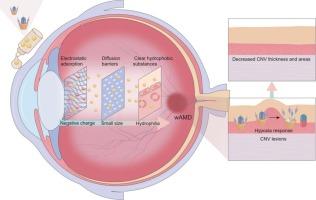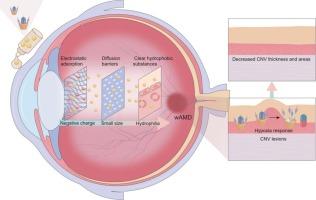治疗眼后节疾病的单分子载体
IF 10.5
1区 医学
Q1 CHEMISTRY, MULTIDISCIPLINARY
引用次数: 0
摘要
滴眼液被认为是治疗眼后节疾病最有前景的非侵入性制剂,但它受到一系列复杂的眼部静态和动态屏障的阻碍。在此背景下,我们提出了一种基于宿主-宿主化学的单分子纳米药物,以实现针对眼后节的高效给药。磺化偶氮[4]炔(SAC4A)具有体积小(长 24.0 Å、宽 21.2 Å、高 14.8 Å,范德华体积为 930 Å3)、带负电荷、亲水性强、装载普遍性和缺氧触发释放等多种特性,因此可作为单分子载体。作为概念验证,我们制备了一种由 SAC4A 与舒尼替尼 (SUN) 复合物形成的眼药水,用于治疗湿性年龄相关性黄斑变性(wAMD)。SAC4A 成功地将 SUN 转运到眼球后段(30 分钟后,SUN@SAC4A 组到达视网膜-脉络膜组织的 SUN 量是 SUN 组的 2.47 倍),显著增强了 SUN 对湿性老年性黄斑变性的抗脉络膜新生血管生成作用,在治疗中发挥了关键作用。我们相信,单分子纳米药物范式在未来治疗各种眼后节疾病方面具有很大的可行性。本文章由计算机程序翻译,如有差异,请以英文原文为准。


A single molecule carrier for ocular posterior segment diseases
Eye drops are envisaged as the most promising non-invasive formulation for the treatment of the ocular posterior segment diseases, while it is hindered by a series of complex ocular barriers, both static and dynamic in nature. In this context, we propose a single molecule nanomedicine based on host-guest chemistry to achieve highly efficient drug delivery targeted to ocular posterior segment. Sulfonated azocalix[4]arene (SAC4A) serves as the single molecule carrier, owing the multiple features of small size (24.0 Å in length, 21.2 Å in width, 14.8 Å in height with a Van der Waals volume of 930 Å3), negative charge, hydrophilicity, loading universality and hypoxia-triggered release. As a proof-of-concept, an eye drop formed by the complexation of SAC4A with sunitinib (SUN) is prepared to treat wet age-related macular degeneration (wAMD). SAC4A successfully transports SUN to the ocular posterior segment (the amount of SUN reaching the retinal-choroid tissue in the SUN@SAC4A group was 2.47 times larger than that in the SUN group at 30 min), significantly enhancing its anti-choroidal neoangiogenesis effect of SUN to wAMD, which played a key role in the treatment. We believe that the single molecule nanomedicine paradigm is highly amenable for treating various ocular posterior segment diseases in the future.
求助全文
通过发布文献求助,成功后即可免费获取论文全文。
去求助
来源期刊

Journal of Controlled Release
医学-化学综合
CiteScore
18.50
自引率
5.60%
发文量
700
审稿时长
39 days
期刊介绍:
The Journal of Controlled Release (JCR) proudly serves as the Official Journal of the Controlled Release Society and the Japan Society of Drug Delivery System.
Dedicated to the broad field of delivery science and technology, JCR publishes high-quality research articles covering drug delivery systems and all facets of formulations. This includes the physicochemical and biological properties of drugs, design and characterization of dosage forms, release mechanisms, in vivo testing, and formulation research and development across pharmaceutical, diagnostic, agricultural, environmental, cosmetic, and food industries.
Priority is given to manuscripts that contribute to the fundamental understanding of principles or demonstrate the advantages of novel technologies in terms of safety and efficacy over current clinical standards. JCR strives to be a leading platform for advancements in delivery science and technology.
 求助内容:
求助内容: 应助结果提醒方式:
应助结果提醒方式:


